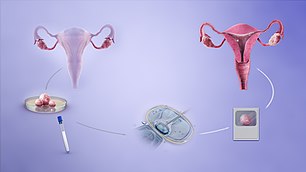Hydrosalpinx
A hydrosalpinx is a condition that occurs when a fallopian tube is blocked and fills with serous or clear fluid near the ovary (distal to the uterus).
As a reaction to injury, the body rushes inflammatory cells into the area, and inflammation and later healing result in loss of the fimbria and closure of the tube.
(Not symptoms) The major cause for distal tubal occlusion is pelvic inflammatory disease, usually as a consequence of an ascending infection by chlamydia or gonorrhea.
While the cilia of the inner lining (endosalpinx) of the fallopian tube beat towards the uterus, tubal fluid is normally discharged via the fimbriated end into the peritoneal cavity from where it is cleared.
If the fimbriated end of the tube becomes agglutinated, the resulting obstruction does not allow the tubal fluid to pass; it accumulates and reverts its flow downstream, into the uterus, or production is curtailed by damage to the endosalpinx.
Other causes of distal tubal occlusion include adhesion formation from surgery, endometriosis, and cancer of the tube, ovary or other surrounding organs.
When laparoscopy is performed, the surgeon may note the distended tubes, identify the occlusion, and may also find associated adhesions affecting the pelvic organs.
Pregnancy rates tended to be low as the infection process often had permanently damaged the tubes, and in many cases hydrosalpinges and adhesions formed again.
Several studies have shown that IVF patients with untreated hydrosalpinx have lower conception rates than controls and it has been speculated that the tubal fluid that enters the endometrial cavity alters the local environment or affects the embryo in a detrimental way.
[6] Indeed, the presence of hydrosalpinx prior to IVF treatments, negatively affects pregnancy rates and increases the risk for spontaneous miscarriage.

